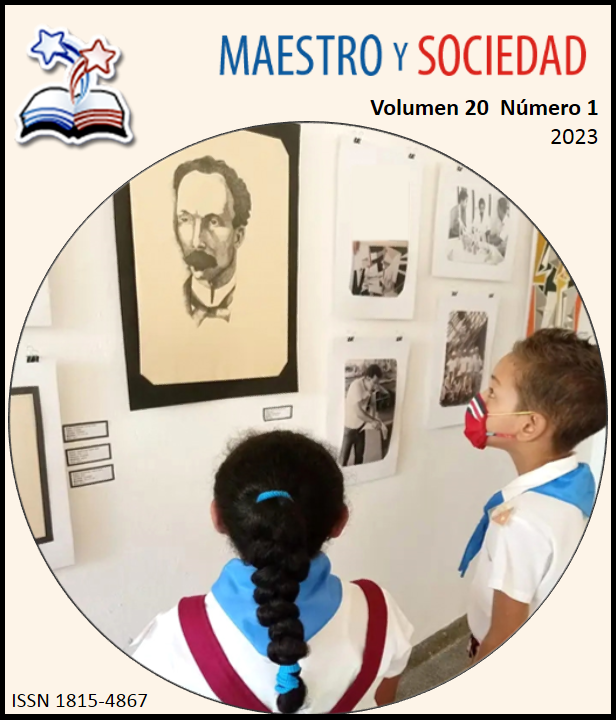Effectiveness of communication between puppets and preschool children. Criteria of María Antonia Fariñas
Effectiveness of communication between puppets and preschool children. Criteria of María Antonia Fariñas
Keywords:
Communication, puppet, puppet theatreAbstract
Introduction: As a manifestation of art, the theater within its typologies integrates puppets. The objective of this research is to determine the effectiveness of communication between puppets, boys and girls of preschool age according to the criteria of the teacher María Antonia Fariñas and not only as a source of entertainment, culture and art, but also as a channel, through which they are transmitted values, patterns and norms of conduct that will contribute to their development.
Materials and methods: For the evaluation of the communication between the puppets, the boys and girls of preschool age, group B was chosen, of preschool, with an enrollment of 20 six-year-old boys and girls, their teacher is Graduated in Pedagogy, specializing in Primary Education, and has 20 years of experience, at the International Student Union School, in the Plaza de La Revolución municipality, in Havana.
Results: This study evaluated the learning of preschool-age boys and girls, verifying later that communication between puppets, boys and girls is effective, entertaining, and instructive.
Discussion: The theatrical representation or the staging of the play in conventional or alternative spaces is an aesthetic manifestation that is structured in a peculiar way, that is, it presents multiple interpretation alternatives and is self-reflexive, since it attracts the attention of the audience. addressee on its own way.
References
- Artiles F. (2005). La maravillosa historia del teatro universal. Editorial Gente Nueva.
- Artiles, Freddy. (1980). La actuación en el teatro de títeres. Editora Extramuros.
- Barreiro, J. (2007). El teatro de títeres en la comunicación social. [Trabajo Escrito Final. Universidad de La Habana].
- Barreiro, J. (2015). María Antonia Fariñas amando las marionetas. Universidad de las Artes.
- Beneventi, P. (2003). Introducción a la historia del teatro para niños y jóvenes. Ediciones Alarcos.
- Darío, R. (2010). Dossier. Teatro para niños y de títeres. La Jiribilla, (88).
- Espinosa, N. (2010). Dossier. Teatro para niños y de títeres. La Jiribilla, (88).
- Fernández, R. (1989). Método de manipulación y trabajo del actor en el teatro de títeres. Editorial Pueblo y Revolución.
- Garbey, M. (2010). Dossier. Teatro para niños y de títeres. La Jiribilla, (88).
- González, A. (2004). Juega y cultiva. (s.e.).
- González, C. (2013). Palabras de inauguración del primer Museo de marionetas del país. (s.e.).
- Martí, J. (1975). Obras Completas. Editorial Ciencias Sociales.
- Martín, J. (2005). Teoría de la comunicación. Epistemología y análisis de la referencia. Editorial A. Corazón.
- Morales, A. (2015). Conferencia en Diplomado de teatro para niños y de títeres. Universidad de las Artes.
- Morales, A. (2004). Títeres: Artes en movimiento. Editorial El mar y la montaña.
- Pavis, P. (2004). Diccionario del teatro: dramaturgia, estética, semiológica. Tomos I y II. Empresa poligráfica de Holguín.
- Saladrigas, H. (2006). Introducción a la teoría y la investigación en comunicación. Editorial Félix Varela.
- Eco, U. (1968). La estructura ausente: introducción a la semiótica. Editorial Lumen.
Downloads
Published
How to Cite
Issue
Section
License
Copyright (c) 2023 Jesús Barreiro Yero, Isabel Cristina García Torrell

This work is licensed under a Creative Commons Attribution-NonCommercial-NoDerivatives 4.0 International License.
This journal provides immediate open access to its content, based on the principle that offering the public free access to research helps a greater global exchange of knowledge. Each author is responsible for the content of each of their articles.



























 Universidad de Oriente
Universidad de Oriente 